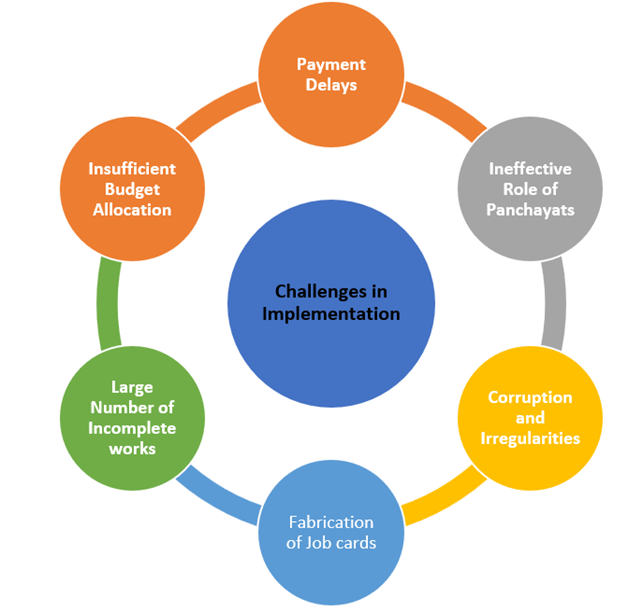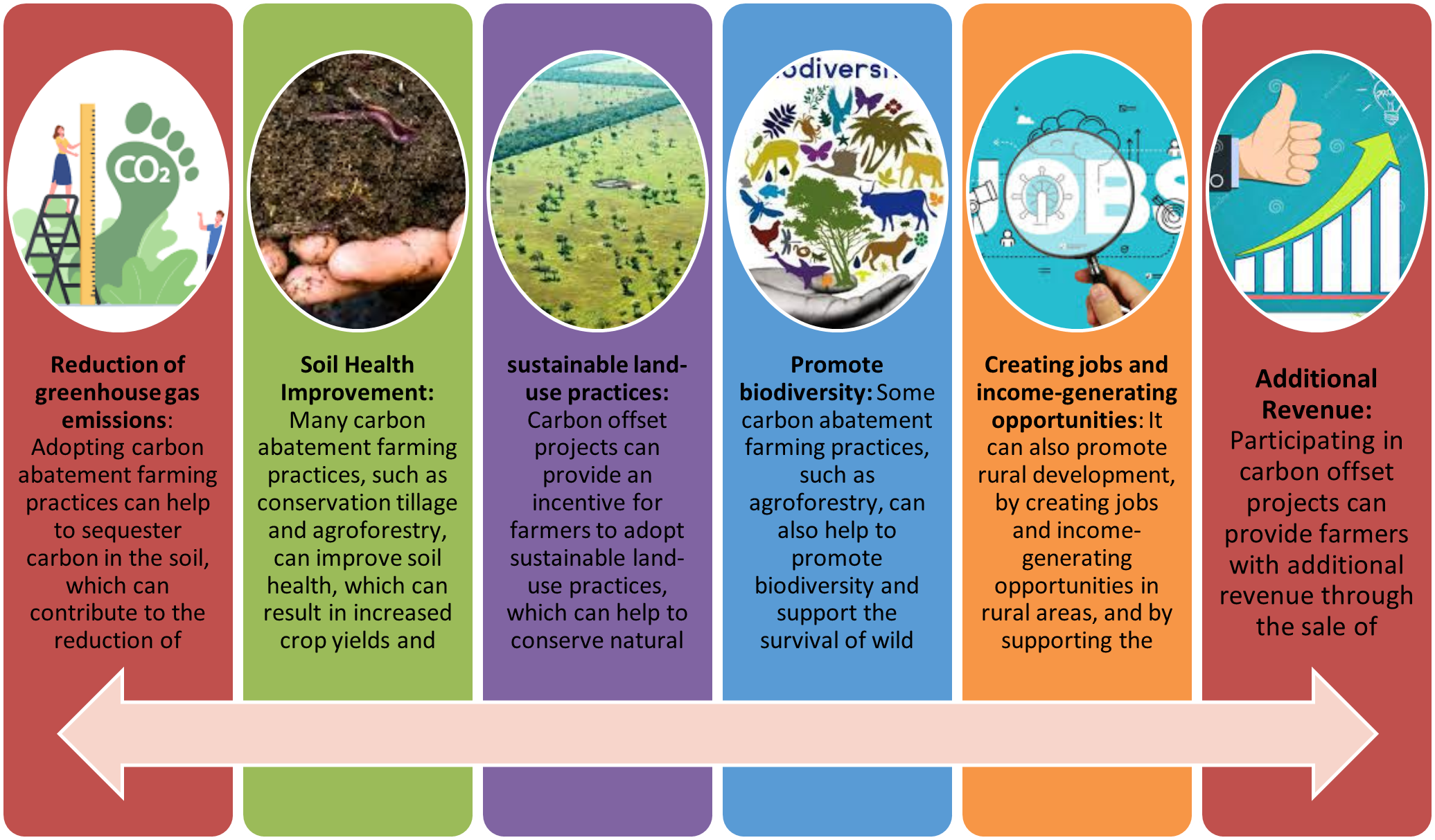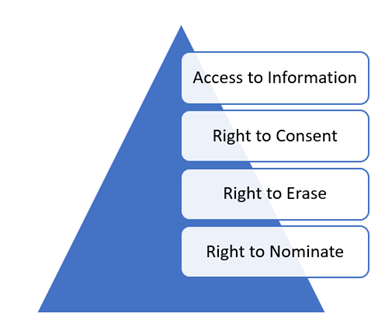Thursday, 2nd February 2023
The task for India’s millet revolution
In News: The Food and Agriculture Organization of the United Nations (FAO) has declared 2023 as the International Year of Millets. Millets have special nutritive properties (they are high in protein, dietary fiber, micronutrients, and antioxidants) and special agronomic characteristics (drought-resistant and suitable for semi-arid regions).
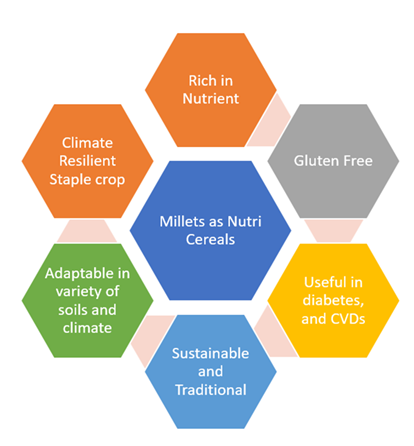
Two groups of millets are grown in India:
- Major millets: Include sorghum, pearl millet, and finger millet.
- Minor millets: Minor millets include foxtail, little millet, kodo, proso, and barnyard millet.
India’s Millet Revolution is driven by growing awareness of the health and environmental benefits of millets, as well as efforts to revive traditional agricultural practices and support small-scale farmers. It is seen as a solution to the country's dual challenges of improving public health and promoting sustainable agriculture.
|
Production and Consumption of cereals in India |
|
Barriers in Millet consumption:
- Decline in the area under millet cultivation: The production of sorghum (jowar) has fallen, the production of pearl millet (bajra) has stagnated, and the production of other millets, including finger millet (ragi), has stagnated or declined.
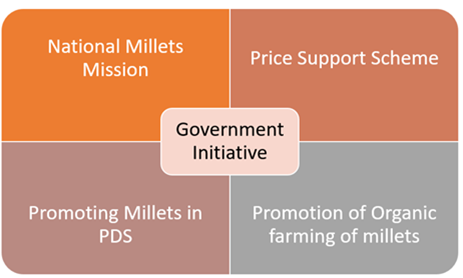
- Low productivity of millet: The productivity of jowar and bajra has increased, but only marginally. The average yield of jowar was 957 kg per hectare in 2011-12 and 989 kg per hectare in 2019-20.
- High Cost: Millets are often priced higher than traditional cereals, making them less accessible to low-income consumers.
- Limited Availability: Millets are not widely available in traditional and modern (e-commerce) retail markets, making it difficult for consumers to purchase them.
- Competition from staple food: Rice and wheat are staple foods in India and are widely available, making it difficult for millets to compete in the market.
- Lack of Government Support: India has not provided enough support to promote the cultivation and consumption of millets, which has limited their growth.
|
Kolli Hills Case Study |
|
Increasing the production of millets and reversing the decline in the area cultivated are feasible steps but not easy, and require multiple interventions including scientific inputs, institutional mechanisms, financial incentives, and in-kind support. The Government of India and State governments, notably Karnataka and Odisha, have initiated Millet Missions.
Small farmers in hilly regions and dryland plains who are among the poorest households in rural India are going to cultivate millets only if it gives them good returns. Adequate public support can make millet cultivation profitable, ensure supply for the PDS, and, ultimately, provide nutritional benefits to a wide section of the population.
https://www.thehindu.com/opinion/lead/tasks-for-indias-millet-revolution/article66450922.ece
Budget on Agriculture - Edukemy Current Affairs
In News:
- Experts highlight the lacklustre allocation to the agriculture sector in Union Budget 2023-24
Major highlights of the bill:
- Although the overall allocation for the agriculture sector increased by 4.7% to Rs 11,55,31.79 crore in 2023-24, when combined with the fund for agricultural research and education, the overall allocation was Rs 12,50,35.79 crore which is down 7% compared to the 2022-23 budget.
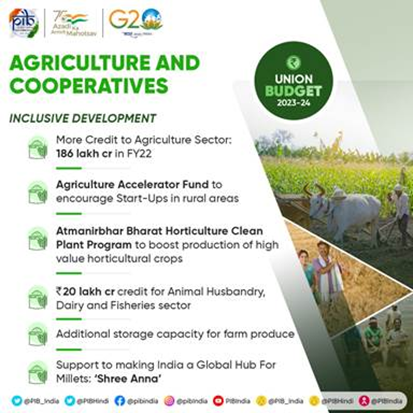
- The share of agriculture in the overall budget fell from 3.36% in 2022 to 2.7% in 2023-24.
- Two major schemes (MIS-PSS and PM-AASHA) that ensure MSP-based procurement operations saw drastic cuts from Rs 1,500 crore to Rs 1 lakh, a 100% cut.
- PM-AASHA allocation was reduced from Rs 1 crore to Rs 1 lakh while PM-KISAN cash incentive scheme allocation remained unchanged at Rs 60,000 crore.
- Private investment in agriculture reached 9.3% in 2020-21, while government investment declined from 5.4% in 2011-12 to 4.3% in 2020-21
- Food and agriculture policy expert believes the biggest problem of enhancing farmers' income has not been addressed.
- Pradhan Mantri Fasal Bima Yojana (crop insurance scheme) was given Rs 13,625 crore, less than the proposed allocation of Rs 15,500 in 2022-23.
- Budget document and FM's speech tilted towards private investment and startups, rather than government spending
Other takeaways from Budget:
- An allocation of Rs 500 crore was made in the 2023-24 budget for Agriculture Infrastructure Fund (AIF) which is for the post-harvest management infrastructure.
- Push on building a digital public infrastructure for agriculture to support farmer-centric solutions.
Important Schemes for Agriculture Sector
|
Schemes |
Important Features |
|
Digital Public Infrastructure for Agriculture |
|
|
Agriculture Accelerator Fund |
|
|
Enhancing productivity of cotton crop |
|
|
Atmanirbhar Horticulture Clean Plant Programme |
|
|
Global Hub for Millets: ‘Shree Anna’ |
|
|
Agriculture Credit |
|
|
Cooperation |
|
MACROECONOMIC AND GROWTH CHALLENGES IN THE INDIAN ECONOMY
In News
As per the Economic Survey 2022-23, the impact of the pandemic and the Russia-Ukraine conflict, on the Indian economy, was outright visible with a significant GDP contraction in FY21. The following year, FY22, the Indian economy started to recover despite the Omicron wave and output went past its pre-pandemic level in FY20, with the Indian economy staging a full recovery ahead of many nations.
About the News
The global economic shocks in the past have been severe but spaced out in time. However, this changed in the third decade of this millennium with three back-to-back shocks that hit economies such as India all across the globe since 2020:
- Pandemic-induced contraction: of the global output.
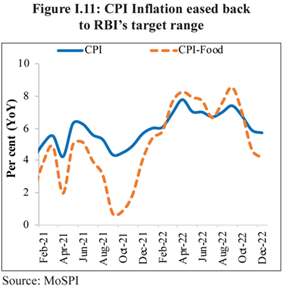
- Russian-Ukraine conflict: led to a worldwide surge in inflation.
- Several central banks’ policy rate hikes: This was led by the Federal Reserve to curb inflation.
What is the Macroeconomic snapshot of India?
- Significant GDP contraction in FY21.
- FY22 saw recovery despite the Omicron wave due to cautious optimism:
- Mobility enabled by localised lockdowns,
- Rapid vaccination coverage,
- Mild symptoms and quick recovery from the virus.
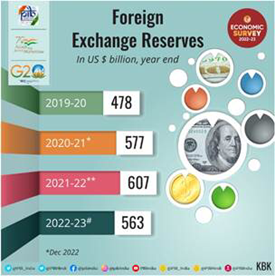
Growth in world trade, of which India was also a beneficiary. India’s exports surged in FY22, and the momentum lasted up to the first half of FY23. Export growth was strong enough to increase India’s share in the world market of merchandise exports.
- FY23 opened with a firm resolve that the pandemic was rapidly on the wane. However, the conflict in Europe necessitated a revision in expectations for economic growth and inflation in FY23.
-
- India’s retail inflation crept above the RBI’s tolerance range of 2%-6% in January 2022 and remained such till November 2022.
- India also saw a further widening of the CAD.
- However, India has sufficient forex reserves to finance the CAD and intervene in the forex market to manage volatility in the Indian rupee.
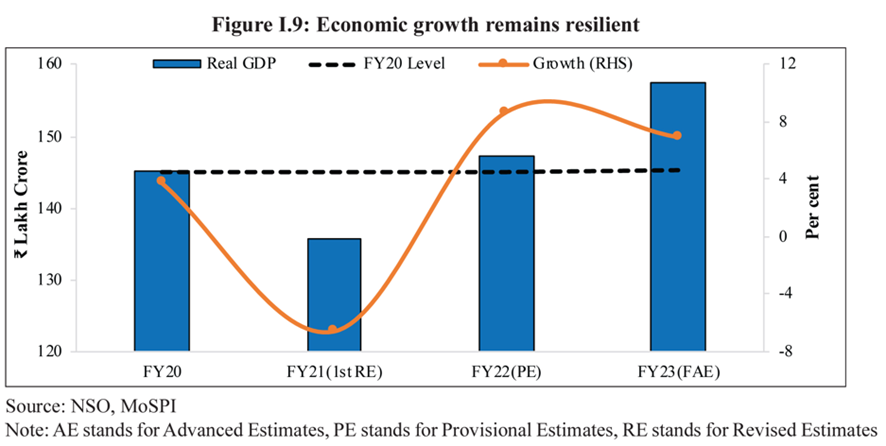
What are the challenges that the Indian economy has been facing since FY22?
- Russia-Ukraine conflict: Led to increased import bills and widening CAD as:
- Oil and gas prices rose to the levels of $100/Barrel. A $1 increase in price rise leads to Rs. 10,700 crore import bill increase on an annualised basis in India.
- Sanctions on Titanium, Palladium, Scandium and Rough diamonds from Russia, affected jewellery, semiconductor, and automobile industries in India.
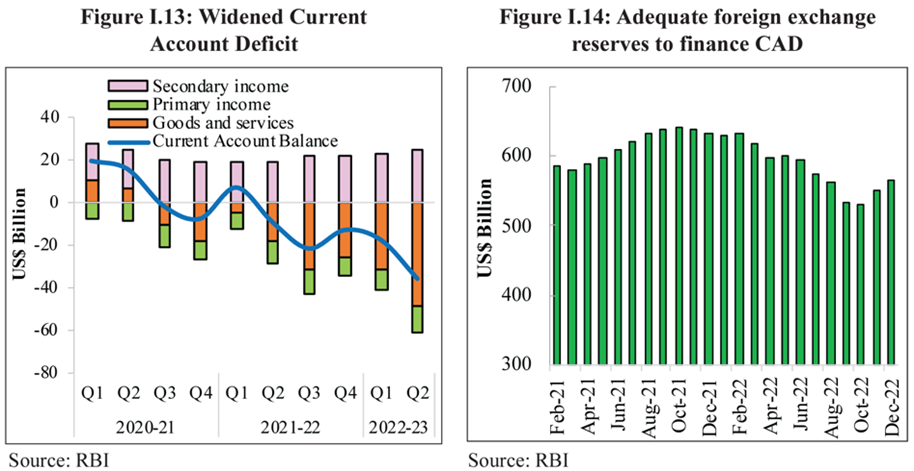
- Local weather conditions: Excessive heat and unseasonal rains kept food prices high.
- Monetary tightening by central banks across the globe: the US dollar has appreciated against several currencies, including the rupee.
- This added to the domestic inflationary pressures besides widening the CAD.
- However, the rupee has been one of the better-performing currencies worldwide.
- Global commodity prices: It further widened the CAD. The major reason behind this is conflict in Europe, which impacted trade as:
- Russia and Ukraine are the suppliers of 75% of the sunflower oil of the world.
- The region is the wheat basket of the world.
- Soybean, corn and barley are also produced at a massive scale in this region.
- Russia supplies 15% of the nitrogen and 17% of potash fertilisers globally.
- Several critical ports closed down.
- Global stagflation: As per United Nations Conference on Trade and Development's (UNCTAD) latest global trade update, global trade growth turned negative in the second half of 2022.
- Inwardness of economic space is a reason behind sluggish growth.
- Geopolitical frictions, persisting inflationary pressures, and subdued demand are expected to suppress global trade further in 2023.
- Loss of education and income-earning opportunities due to scarring from the pandemic.
Source:
https://www.indiabudget.gov.in/economicsurvey/
INDIA’S INCLUSIVE GROWTH - Edukemy Current Affairs
In News
India has reinforced the country’s belief in its economic resilience as it has withstood the challenge of mitigating external imbalances caused by the pandemic and the Russian-Ukraine conflict without losing sight of inclusive economic growth in the process.
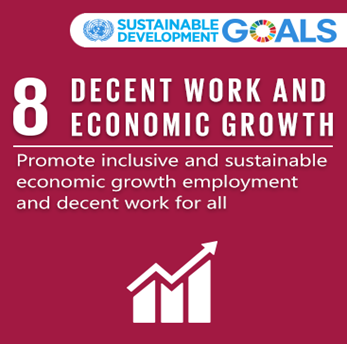 What is inclusive growth?
What is inclusive growth?
As per OECD, Inclusive growth is economic growth that is distributed fairly across society and creates opportunities for all. In short, growth is inclusive when it creates jobs. There are ways to make this happen:
- Making tax systems fairer and more effective.
- Ensuring people are able to earn wages they need to thrive.
- Creating a business environment that attracts new firms and boosts communities.
- Adaptation to and mitigation of climate change effects.
 What are the indicators showing inclusive growth in India in the FY23?
What are the indicators showing inclusive growth in India in the FY23?
With the initial surge in exports, a strong release of the “pent-up” demand, and a swift rollout of the capex, job creation appears to have moved into a higher orbit.
- The Periodic Labour Force Survey (PLFS) shows that the urban unemployment rate for people aged 15 years and above declined from 9.8% in the quarter ending September 2021 to 7.2% one year later (quarter ending September 2022).
- There has been an improvement in the labour force participation rate (LFPR) as well.
- The UNDP Report of July 2022 stated that the recent inflationary episode in India would have a low poverty impact due to well-targeted support.
- The National Family Health Survey (NFHS) in India shows improved rural welfare indicators from FY16 to FY20, covering aspects like gender, fertility rate, household amenities, and women empowerment.
What were some government initiatives that led to inclusive growth in the Indian economy?
- In FY21, the Government announced the Emergency Credit Line Guarantee Scheme (ECLGS).
- It succeeded in shielding micro, small, and medium enterprises (MSMEs) from financial distress.
- A recent CIBIL report (ECLGS Insights, 2022) showed that the scheme has supported MSMEs in facing the COVID shock, with 83% of the borrowers that availed of the ECLGS being micro-enterprises.
- The CIBIL data also shows that ECLGS borrowers had lower non-performing asset rates than enterprises that were eligible for ECLGS but did not avail of it.
- The GST paid by MSMEs after declining in FY21 has been rising since and now has crossed the pre-pandemic level of FY20, reflecting the financial resilience of small businesses and the effectiveness of the pre-emptive government intervention targeted towards MSMEs.
- Mahatma Gandhi National Rural Employment Guarantee Act (MGNREGA) has been rapidly creating more assets in respect of “Works on individual’s land” than in any other category.
- PM-KISAN, which benefits households covering half the rural population, and PM Garib Kalyan Anna Yojana have significantly contributed to lessening impoverishment in the country.
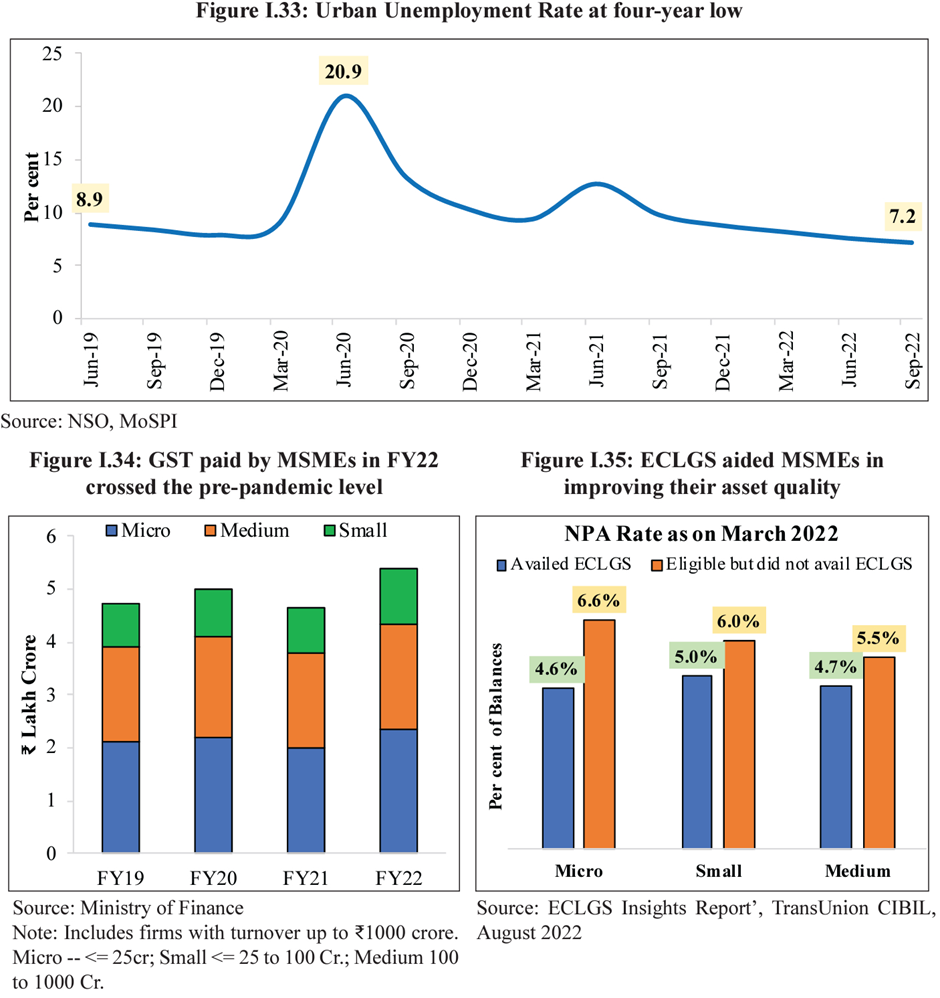
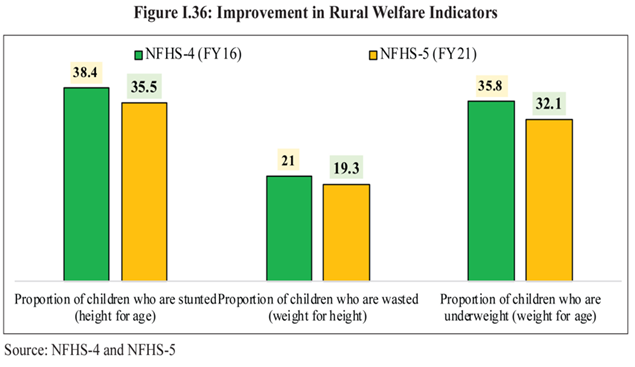
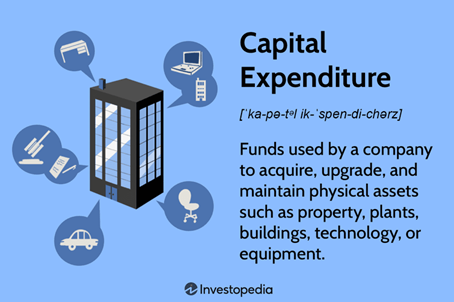 What is the role of the private sector in inclusive growth?
What is the role of the private sector in inclusive growth?
- Since export growth is plateauing and the “pent-up” release of demand will have a finite life, it is essential that capex continues to grow to facilitate employment in the economy until the global economy rebounds.
- The private sector can do the capex heavy lifting as it has all the necessary pre-conditions lined up to step up to the plate:
- Internal resource generation is good,
- Capacity utilization is high,
- Demand outlook continues to improve, and
- Capital markets and financial institutions are willing to finance new investments.
Source:
https://www.indiabudget.gov.in/economicsurvey/
Pallas Cat - Edukemy Current Affairs
In news
- Recently Pallas’s Cat was discovered for the first time in Sagarmatha National Park (Nepal).

About
- The Pallas cat, also known as the manul, is a small wild cat with long and dense light grey fur, and rounded ears which is a unique feature among small cats.
- It is well adapted to the cold continental climate in its native range, which receives little rainfall and experiences a wide range of temperatures.
- It has also been spotted in the Caucasus, Iranian Plateau, Hindu Kush, parts of the Himalayas, Tibetan Plateau, Altai-Sayan region, and South Siberian Mountains.
- It inhabits rocky montane grasslands and shrublands, where the snow cover is below 15–20 cm (6–8 in).
- It finds shelter in rock crevices and burrows and preys on lagomorphs and
Threats:
Immediate threats to Pallas’s cat are the presence of free-ranging dogs and expanding human activities like military presence, tourism, and related developmental activities in the Changthang region. The problems are interlinked.
Conservation Status:
- IUCN: Near Threatened
- CITES: Appendix II
Sagarmatha National Park
- Sagarmatha is an area with mountains, glaciers and deep valleys, dominated by Mount Everest.
- It is located in the Solu-Khumbu district of Nepal where the highest peak of the world is situated.
- Rare species such as snow leopards and red pandas are also found in this area.
- Sherpa community dominates this area.
- It is recognized by UNESCO as a world heritage site in
https://www.downtoearth.org.in/gallery/wildlife-and-biodiversity/cat-on-the-roof-of-the-world-pallas-s-cat-dna-found-on-mount-everest-87354
India's 16th Finance Commission: Strengthening Fiscal Stability
In News
The 16th Finance Commission of India shall be constituted soon.
About
- The Finance Commission is constituted by the President under article 280 of the Constitution.
- It is a quasi-judicial body constituted every 5th year.
Objective
- The main objective is to give recommendations on distribution of tax revenues between the Union and the States and amongst the States themselves.
- It strengthens the principle of cooperative federalism as it is characterized by consultation at all levels.
- It has the responsibility of improving the quality of public spending and promoting fiscal stability.
- The First Finance Commission was constituted with Presidential Order under the chairmanship of Shri K.C. Neogy on 6th April 1952.
Core Responsibilities
- the distribution between the Union and the States of the net proceeds of taxes which are to be, or maybe, divided between them and the allocation between the States of the respective shares of such proceeds;
- the principles which should govern the grants-in-aid of the revenues of the States out of the Consolidated Fund of India;
- the measures needed to augment the Consolidated Fund of a State to supplement the resources of the Panchayats in the State on the basis of the recommendations made by the Finance Commission of the State;
- the measures needed to augment the Consolidated Fund of a State to supplement the resources of the Municipalities in the State on the basis of the recommendations made by the Finance Commission of the State;
- any other matter referred to the Commission by the President in the interests of sound finance.
- The Commission determines its procedure and has such powers in the performance of its functions as Parliament may by law confer on them.
https://www.thehindu.com/news/national/process-to-set-up-sixteenth-finance-commission-set-to-kick-off-soon/article66451389.ece
Thalattosuchian - Edukemy Current Affairs
In news
- Recently scientists have uncovered a new thalattosuchian—an ancient “cousin” of modern-day crocodiles.
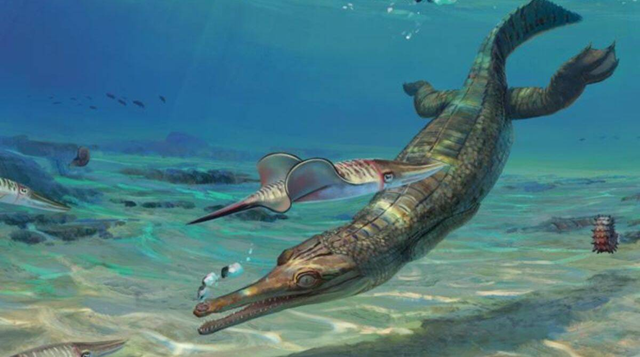
About
- The fossils were discovered on the Jurassic Coast (the U.K.).
- The body parts uncovered include part of the head, backbone, and limbs of Turnersuchus hingleyae.
- They are assumed to look like gharial crocodiles (largely spotted in major North Indian rivers) because of their relatively long, slender snouts.
- Though thalattosuchians’ skulls looked similar to gharial crocodiles, they were constructed differently.
- The region of the skull housing jaw muscles was particularly large in the species, suggesting that they had enlarged jaw muscles that made fast bites possible.
- This would have been useful considering that most of their prey were probably fast-moving fish and cephalopods like squids and octopuses.
- Analyses suggest that Thalattosuchians likely first appeared in the Triassic and survived the end-Triassic mass extinction.
- The newly-discovered fossils of Turnersuchus hingleyae represent the only complete Thalattosuchian of its age and date back to the early Jurassic, Pliensbachian period, which was about 185 million years ago.
https://indianexpress.com/article/technology/ancient-marine-crocodile-fossil-8415408/
Ukraine’s Odesa in UNESCO's World Heritage List
Why in news? Recently, the World Heritage Committee decided to add the historic centre of Ukraine’s Black Sea port city of Odesa to its list of World Heritage sites.
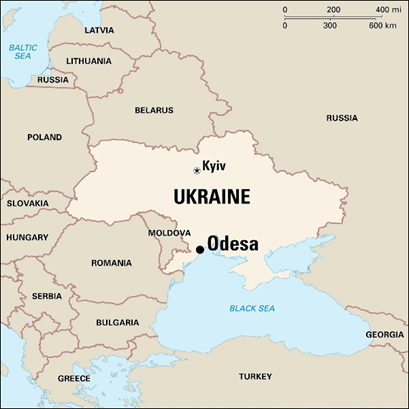
About:
- It is located about 500 kilometres from Ukraine's capital Kyiv.
- It is known as the pearl of the Black Sea.
- The Historic Centre of Odesa has also been inscribed on the List of World Heritage in Danger.
- The List of World Heritage in Danger is designed to inform the international community of conditions that threaten the very characteristics for which a property was inscribed on the World Heritage List and to encourage corrective action.
- As of 2023, the 52 properties are decided by the Committee to include on the List of World Heritage in danger.
- Seven other sites in Ukraine have been added to UNESCO’s World Heritage List, including the Saint-Sophia Cathedral in the capital Kyiv and the historic centre of the western city of Lviv.
https://news.un.org/en/story/2023/01/1132942
Armenia-Azerbaijan Conflict - Edukemy Current Affairs
Why in news? Recently, Armenia has released a map claiming to show the territory seized by Azerbaijani forces during clashes since the 2020 Second Nagorno-Karabakh War.

About:
- Nagorno-Karabakh is within Azerbaijan but had been under the control of ethnic Armenian forces since 1994 when a separatist war ended.
- The conflict can be traced back to the pre-Soviet era when the region was at the meeting point of Ottoman, Russian and the Persian empires.
- The self-declaration of independence by Nagorno-Karabakh in September 1991 in the backdrop of an imminent collapse of the Union of Soviet Socialist Republics (USSR) resulted in a war between Azerbaijan and Nagorno-Karabakh — supported by Armenia.
https://oc-media.org/armenia-releases-map-of-territories-seized-by-azerbaijan-since-2020/
India-UAE CEPA - Edukemy Current Affairs
Why in news? Recently, Prime Minister has lauded the utilization of the India-UAE Comprehensive Economic Partnership Agreement (CEPA) by Indian Exporters.

About:
- India-UAE CEPA is the first deep and full free trade agreement (FTA) signed by India with any country in the past decade.
- It officially entered into force in May 2022.
- It covers Trade in Goods, Rules of Origin, Trade in Services, Technical Barriers to Trade (TBT), Sanitary and Phytosanitary (SPS) measures, Dispute Settlement etc.
- India has already signed a CEPA with Japan and South Korea.
- Significance: expected to increase the total value of bilateral trade in goods to over US$100 billion and trade in services to over US$ 15 billion within five years.
https://indiaeducationdiary.in/pm-narendra-modi-lauds-utilisation-of-india-uae-cepa-by-indian-exporters/
Reverse flipping - Edukemy Current Affairs
Why in news? Economic Survey 2022-23 states that start-ups are exploring "reverse-flipping".

About:
- Flipping is the process of transferring the entire ownership of an Indian company to an overseas entity.
- It is generally accompanied by a transfer of all intellectual property and data owned by an Indian company.
- It effectively transforms an Indian company into a 100% subsidiary of a foreign entity.
- Reverse Flipping is the process of shifting the domicile of those companies back to India who flipped earlier.
https://timesofindia.indiatimes.com/business/startups/companies/indian-startups-are-looking-at-reverse-flipping/articleshow/97499074.cms
White Rann of Kutch - Edukemy Current Affairs
Why in news? Mega Khadi fashion show, the first ever on Rann of Kutch, was organizedthe by Khadi and Village Industries Commission (KVIC).

About:
- Rann of Kutch is a salt marshy land in the Thar Deserthe t in Kachchh district of western Gujarat.
- It is the largest salt desert in the world.
- It includes Great Rann of Kachchh, Little Rann of Kachchh, and Banni grassland.
- It is part of the Indian wild ass sanctuary, and Kachchh desert wildlife sanctuary.
- It is home to the only remaining population of chestnut-colored Indian wild ass (khur), as well as blue bulls, blackbuck, and chinkara.
https://pib.gov.in/PressReleasePage.aspx?PRID=1895053
Spider Pulsar Systems - Edukemy Current Affairs
Why in news? Recently, Scientists have discovered the first gamma-ray eclipses from a special type of binary star system by using NASA’s Fermi Gamma-ray Space Telescope.

About:
- It is a binary star system in which a superdense star (pulsar) spins quickly, eats another star.
- The super-dense object that begins to pull a matter from the companion resembles the habits of spiders of the genus Latrodectus, in which the female eats the male after mating, hence the name came.
- Initially, the dense pulsar strips material from the outer atmosphere of its companion, periodically shedding the gathered material in violent explosions.
- In the later stage of their lifetimes, the energetic particles streaming out of the pulsar can strip the atmosphere of its companion.
- In either case, the pulsar slowly erodes its companion over time.
- Two varieties of binary systems containing pulsars.
- Black widows: Binary pulsar systems, in which the mass of a companion star is less than 5 % of the solar one.
- Redback: Binary pulsar systems, in which the mass of a companion star is from 10 to 50 % of the solar.
https://tech.hindustantimes.com/tech/news/nasa-discovers-first-gamma-ray-eclipses-from-spider-star-systems-71674817536573.html
Share the article
Get Latest Updates on Offers, Event dates, and free Mentorship sessions.

Get in touch with our Expert Academic Counsellors 👋
FAQs
UPSC Daily Current Affairs focuses on learning current events on a daily basis. An aspirant needs to study regular and updated information about current events, news, and relevant topics that are important for UPSC aspirants. It covers national and international affairs, government policies, socio-economic issues, science and technology advancements, and more.
UPSC Daily Current Affairs provides aspirants with a concise and comprehensive overview of the latest happenings and developments across various fields. It helps aspirants stay updated with current affairs and provides them with valuable insights and analysis, which are essential for answering questions in the UPSC examinations. It enhances their knowledge, analytical skills, and ability to connect current affairs with the UPSC syllabus.
UPSC Daily Current Affairs covers a wide range of topics, including politics, economics, science and technology, environment, social issues, governance, international relations, and more. It offers news summaries, in-depth analyses, editorials, opinion pieces, and relevant study materials. It also provides practice questions and quizzes to help aspirants test their understanding of current affairs.
Edukemy's UPSC Daily Current Affairs can be accessed through:
- UPSC Daily Current Affairs can be accessed through Current Affairs tab at the top of the Main Page of Edukemy.
- Edukemy Mobile app: The Daily Current Affairs can also be access through Edukemy Mobile App.
- Social media: Follow Edukemy’s official social media accounts or pages that provide UPSC Daily Current Affairs updates, including Facebook, Twitter, or Telegram channels.

